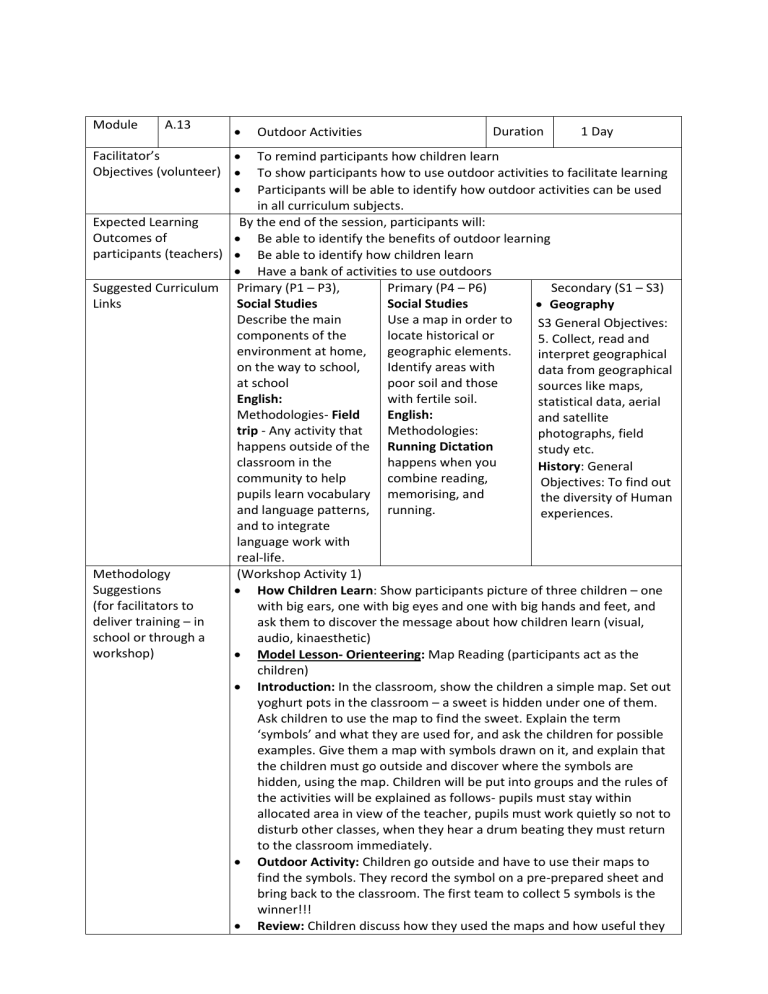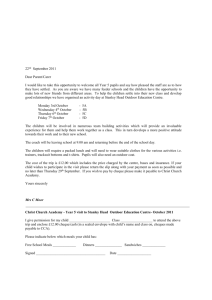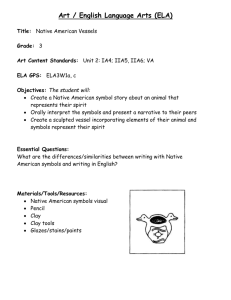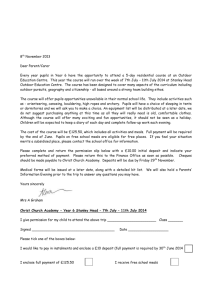A.13. Outdoor Activities
advertisement

Module A.13 Facilitator’s Objectives (volunteer) Outdoor Activities Duration 1 Day To remind participants how children learn To show participants how to use outdoor activities to facilitate learning Participants will be able to identify how outdoor activities can be used in all curriculum subjects. Expected Learning By the end of the session, participants will: Outcomes of Be able to identify the benefits of outdoor learning participants (teachers) Be able to identify how children learn Have a bank of activities to use outdoors Suggested Curriculum Primary (P1 – P3), Primary (P4 – P6) Secondary (S1 – S3) Links Social Studies Social Studies Geography Describe the main Use a map in order to S3 General Objectives: components of the locate historical or 5. Collect, read and environment at home, geographic elements. interpret geographical on the way to school, Identify areas with data from geographical at school poor soil and those sources like maps, English: with fertile soil. statistical data, aerial Methodologies- Field English: and satellite trip - Any activity that Methodologies: photographs, field happens outside of the Running Dictation study etc. classroom in the happens when you History: General community to help combine reading, Objectives: To find out pupils learn vocabulary memorising, and the diversity of Human and language patterns, running. experiences. and to integrate language work with real-life. Methodology (Workshop Activity 1) Suggestions How Children Learn: Show participants picture of three children – one (for facilitators to with big ears, one with big eyes and one with big hands and feet, and deliver training – in ask them to discover the message about how children learn (visual, school or through a audio, kinaesthetic) workshop) Model Lesson- Orienteering: Map Reading (participants act as the children) Introduction: In the classroom, show the children a simple map. Set out yoghurt pots in the classroom – a sweet is hidden under one of them. Ask children to use the map to find the sweet. Explain the term ‘symbols’ and what they are used for, and ask the children for possible examples. Give them a map with symbols drawn on it, and explain that the children must go outside and discover where the symbols are hidden, using the map. Children will be put into groups and the rules of the activities will be explained as follows- pupils must stay within allocated area in view of the teacher, pupils must work quietly so not to disturb other classes, when they hear a drum beating they must return to the classroom immediately. Outdoor Activity: Children go outside and have to use their maps to find the symbols. They record the symbol on a pre-prepared sheet and bring back to the classroom. The first team to collect 5 symbols is the winner!!! Review: Children discuss how they used the maps and how useful they were. Children then draw a map of the classroom using symbols to identify furniture etc. (Workshop Activity 2) Group Work (according to class level/subject): Give participants copies of the curriculum and ask them to identify activities that can be done outside. Record ideas on flipchart paper and share with the group afterwards. Choose one or more of the following activities to practice with the participants: Nature Walk Maths trail Gardening Looking after animals (e.g. rabbits) Games (refer to module on games) Soil: identify and classify parts of soil, erosion Dance/drama Treasure Hunt (adapted to Maths, English) Sport Our community – identify buildings in our school/community Interviews with members of the local community Resources Needed Any Other Information (School Based Activity) Team teaching: Introduce the participants to managing group/pair work inside/outside the classroom. Discuss roles and responsibilities e.g. choosing an appropriate ‘leader’ for each group, a ‘secretary’, ‘reporter’ and other roles as applicable to the activity. Discuss the concept of time management, and how you can use different signals for gaining attention etc. Model one of the activities from the above list with the children (facilitator is the teacher, and others observe and take notes). After the lesson, ask the teachers to give feedback – two stars and a wish. Trainer can visit their ‘advanced teachers’ helping them to plan, teach and evaluate lessons that include outdoor activities. Trainer must provide support and encouragement in order to develop their confidence. Yoghurt pots Map of school grounds Map of class Sweets or another prize Flipchart paper Marker pens Tape Symbols on pieces of paper/card/rice sack e.g. heart, circle, star, x Hard copies of the curriculum for all subjects Teachers should be encouraged to take children out of the classroom into their local environment. This is something they are not comfortable doing, mainly because of the challenge of managing the children in an open space. They must be given strategies to use in order to make this manageable. They will need support and encouragement to keep trying Inclusion until a routine is established. These activities are an excellent way to include all children. They are visual, audio and kinaesthetic which meets the learning styles of most children. Groups should be mixed ability, and leaders chosen carefully who will ensure all children participate. The needs of children with specific impairments will need to be considered. E.g. a local ‘trail’ can be created with rope (for visually impaired) or easy terrain (for children with ambulatory impairments).







